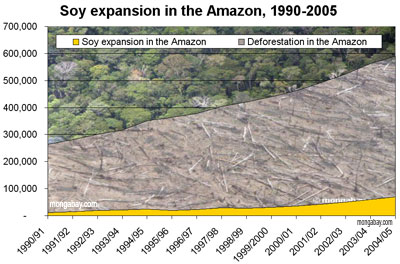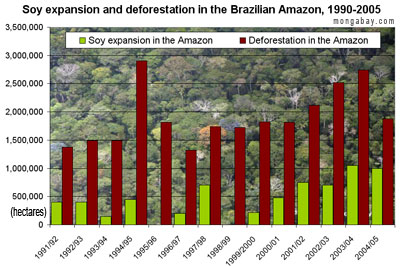An industry-led ban on soy production in the Amazon appears to be proving effective at reducing new clearing for explicit soy production, according to a survey published Monday by Greenpeace and the Brazilian Vegetable Oils Industry Association.
The moratorium, which was signed by some of the largest soy crushers in the Amazon in response to a campaign by environmental group Greenpeace, went into effect in October 2006.
While soy is believed to be having an indirect impact on deforestation by driving up land prices and competing with the dominant form of land use in the Amazon — cattle ranching — the news is a hopeful sign for conservationists.
“Without a doubt the results show that soy moratorium is being respected and that is good news,” Paulo Adario, coordinator of Greenpeace’s Amazon campaign, was quoted as saying by the Associated Press. The report found no new soybean plantations in any of the 193 areas that showed deforestation of 100 hectares (250 acres) or more between August 2006 and August 2007.
Still Adario cautioned that high soy prices are continuing to put pressure on forest lands in the Brazilian Amazon.
 Soy expansion in the Brazilian Amazon, 1990-2005 Total deforestation and area of soybean cultivation across states in the Brazilian Amazon. Overall soybean cultivation makes up only a small portion of deforestation, though its role is accelerating. Further, soybean expansion and the associated infrastructure development and farmer displacement is driving deforestation by other actors. Note: some soybean farms are established on already degraded rainforest lands and neighboring cerrado ecosystems. Therefore it would be inappropriate to assume the area of soybean planting represents its actual role in deforestation.  Annual deforestation rates and annual soy expansion for states in the Brazilian Amazon 1990-2005. Note that the 1995-1996 and 1998-1999 years were negative and do not show up on the chart. Graphs based on Brazilian government data. |
“However, the high prices of soy on the international market are increasing producers’ appetites for more land, which creates and important challenge for the companies committed to the moratorium,” he told the Associated Press, adding that much of deforestation cited in the report has occurred adjacent to existing soybean plantations, suggesting that developers could expand soy fields into these areas.
Typically rainforest lands are cleared for low-intensity cattle ranching then sold to soy producers some two to three years later. With land prices appreciating and soy cultivation expanding in previously cleared areas and the neighboring cerrado grassland ecosystem, ranching is increasingly displaced to frontier areas, spurring deforestation.
“Ranchers who sell their land to planters of soya or cane can purchase areas 10 times as large on the frontier, owing to the strong differential in land prices,” wrote Dr. Donald Sawyer, an associate professor at the Center for Sustainable Development at the University of Brasilia, in a paper on the impact of biofuels on the Amazon published in March in Philosophical Transactions of the Royal Society B.
Scientists say that the soy industry’s push for infrastructure improvements is also contributing to forest conversion.
“The powerful Brazilian soy lobby has been a driving force behind initiatives to expand Amazonian highway networks, which greatly increase access to forests for ranchers, farmers, loggers, and land speculators,” said Dr. William F. Laurance, a researcher at the Smithsonian Tropical Research Institute, who has argued that there is an American “corn connection” to Amazon deforestation. Laurance says that corn ethanol subsidies are providing impetus for rainforest conversion for agricultural purposes.